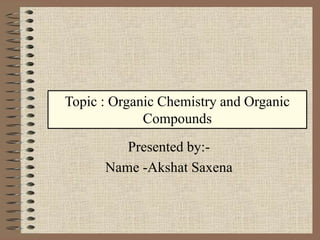
Introduction to Organic Chemistry
- 1. Presented by:- Name -Akshat Saxena Topic : Organic Chemistry and Organic Compounds
- 2. Contents • What is Chemistry? • Origin of Organic Chemistry • Earlier Theories. • Modern Defination. • Why Organic chemistry a separate branch? • Classification of Organic Compounds.
- 3. What is Chemistry? Chemistry is the branch of science which deals with matter,its composition,its structure,its property and its transformation from one form to another form.
- 4. Main Branches of Chemistry Chemistry Physical Chemistry Inorganic Chemistry Organic Chemisty
- 5. Earlier Theories Based on their source, chemical compounds are classified into three types by Lemery: i) Mineral sourced. ii) Vegetable sourced. iii) Animal sourced. Lavoiser founded that the compounds from vegetable and animal sources contain similar composition.
- 6. Then Berzelius classified the above three types into two types and he coined the new terms Organic and Inorganic. i) Organic compounds: These are present in living beings (plants, animals etc.) ii) Inorganic compounds: These are present in minerals.
- 7. Origin of Organic Chemistry • Scheele extracted tartaric acid from grapes and citric acid from lemons. • Roulle isolated urea from human urine. • Serturner prepared morphine from opium. • This discoveries led to increment of interest among the scientists towards organic compounds.
- 8. Vital Force Theory • This theory is also known as Bio-force Theory. • ‘Vital Force Theory’ was given by ‘Jons Jacob Berzelius’ in 1808. • Therefore, he is known as ‘Father of Organic Chemistry’. • According to him, “We can not prepare Organic Compounds in the laboratory because ‘vital force’ is absent there.”
- 9. Organic Compounds can only be Prepared by living things because they have vital force. • Other scientist supported Berzelius and he suggested that we should study Organic Chemistry separately because they have unique properties. • Then introduced a new branch of chemistry known as ‘Organic Chemistry’.
- 10. Break-down of Vital Force Theory • In 1828,Friedrich Wohler ,a German Chemist, prepared Urea as the first organic compound in laboratory and broke Vital force Theory. • He was actually preparing ammonium cynate(NH4CNO) from ammonium Chloride (NH4CL).
- 11. The reaction is NH4CL + KCNO NH4CNO + KCL But , he heated it much and then rearrangement reaction took place,which formed Urea. NH4CNO NH2CONH2 Ammonium Urea cynate (A well known Organic (A typical inorganic Compound) compound)
- 12. After that, • Kolbe synthesised CH3COOH from its elements. • Berthelot synthesised CH4 • Carbon is tetravalent as it contains four unpaired electrons in its excited state configuration. The tetravalency of carbon was given by Vanthoff and Lebel who were awarded the first nobel prize in chemistry.
- 13. Modern Defination Compounds which are made by carbon and hydrogen are known as Hydrocarbon. The branch of chemistry dealing with the study of hydrocarbons and the compounds which could be thought of as the derivatives of hydrocarbons is called Organic chemistry.
- 14. Why Organic Chemistry is a separate branch? • Large number of organic Compounds. • Composition of Organic Compounds. • Complexity of molecules. • Most of the Properties are decided by functional groups. • They contain covalent bonds between carbon and carbon as well as between other elements.
- 15. • They shows property of isomerism. • They have low melting and boiling points as compared to inorganic compounds. • They are not soluble in non-polar solvents. • Combustibility • Nature of Chemical reactions.
- 16. Organic Compounds Open Chain or Acyclic Compounds Saturated (Alkanes) Unsaturated AlkyneAlkene Closed chain or Ring Compounds Homocyclic Compounds Alicyclic Compounds Aromatic Compounds Heterocyclic Compounds
- 17. Further reading en.wikipedia.org/wiki/Organic_chemistry www.britannica.com/ www.ocw.mit.edu/ Modern ABC for class XI ISC Chemistry Morrison & Boyd
- 18. Thank You
